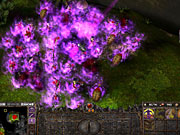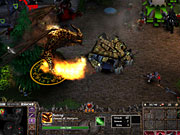Frodo? Check. Gandalf? Check. Balrog? Big check. It looks like the entire gang made it for The Lord of the Rings: War of the Ring, Vivendi Universal's real-time strategy game set in J.R.R. Tolkien's seminal Middle-earth. It's not hard to imagine that Vivendi and developer Liquid Entertainment hoped to cash in on the Lord of the Rings craze with the release of this game. Unfortunately, despite the presence of some recognizable characters, that's what the game ends up feeling like. War of the Ring has gameplay that could have been lifted straight out of any generic fantasy-themed real-time strategy game from several years ago.

War of the Ring is split into two 10-mission campaigns, giving you a behind-the-scenes look at the epic conflict from both sides. Playing the good campaign explains how it was that Legolas, Gimli, and Boromir all managed to show up at Rivendell just in time to join the Fellowship of the Ring. Meanwhile, the evil campaign tells how the forces of Sauron managed to break out of Mordor and besiege the city of Minas Tirith.
The game conforms to the traditional real-time strategy model that you've probably seen and played before. You start off with a handful of units and must immediately establish a base and begin collecting the game's two resources: wood and ore. Then you start churning out units while you pursue the upgrade path on the research tree. When you've finally amassed a large enough force, it's time to venture out and attack the enemy. It's a tried-and-true formula that does offer visceral thrills when you crush your opponent, and, if done right, it's a formula that can be very challenging and rewarding.
The problem is that War of the Ring suffers from a limp artificial intelligence and bland level design. In essence, the easiest path to victory is to simply outproduce your opponent. The end result is that beating most missions involves hunkering down in a defensive position and researching all the upgrades you researched in the last mission just so you can pump out the game's uberunits. Churn out about a dozen of these, lasso them with the mouse, and click on the enemy's base. Sit back, relax, and repeat the process in the next mission.
At the default difficulty level, the AI is ridiculously easy to beat in the good campaign. For the majority of the missions, all it does is send token raiding parties your way every few minutes, just to keep you honest. These raids are easily beaten back, and they never escalate in scale or threat to you. This behavior is puzzling considering that in skirmish mode, the same default AI is actually pretty aggressive and will stomp you if you're not careful. You can't help but get the feeling they've nerfed the good campaign so that it appeals to casual players. However, if you want more of a challenge, you have to play the evil campaign, which was made for veteran players. There the levels are designed in a way that force you to venture out early to locate and secure secondary outposts that you must then defend. More importantly, the AI plays a much more aggressive game. The end result is that you experience some very harrowing missions, especially a defend-the-Alamo-style battle where your orcs have to repulse consecutive waves of Gondor horsemen.
The developers did add a twist to the real-time strategy formula, which they called "fate." Basically, this can be thought of as a karmic system of sorts. The more damage you inflict on the enemy, the more fate points you're rewarded. You can use individual fate points to acquire bonuses for your heroes, like getting Frodo his sword Sting, or you can even use them to recruit a new hero, like Aragorn. The real treat happens if you save up a large reservoir of fate points. Then you can cast some epic spells that play a decisive role in combat, such as the "murder of crows" spell, which summons a swarm of the black birds to encircle your units, absorbing all missile attacks. By using another spell, you can summon a gigantic creature, like the Balrog.
Skirmish and multiplayer have a wide range of options, from the obligatory deathmatch to a few exotic game types. The best of these is catapult, which is based on one of the game's single-player missions. As the name suggests, there's a gigantic catapult on the map somewhere, and the goal is to locate and seize control of it so you can rain gigantic boulders on enemy bases. The trick, of course, is trying to keep your base adequately defended while at the same time trying to seize and maintain control of the catapult. This is difficult, of course, because your opponent will throw waves of attackers at you in a desperate attempt to seize it for himself. It makes for some good fun as you try to race forces around the map to where they're needed most.

Graphically, War of the Ring suffers somewhat from the fact that it's built on the Battle Realms engine, which is 2-year-old technology. They've spruced things up a bit, like including shiny water and seas of grass that part as your units run through them. However, most units and buildings look blocky; especially when you zoom down to get a close-up on the action. For instance, faces on dwarf units are badly plastered onto a single polygon. There are some graphical highlights, though. Most of the hero and villain characters look pretty good, and it's fun to see the nazgul gallop into battle, swords swinging. But the best-looking creature, by far, in the game is the Balrog. Just imagine a lumbering, Godzilla-like fire demon snapping a flame whip! That's pretty much what Liquid's re-created onscreen. It's just a stunning moment when he first appears, and it makes you wish that the rest of the units looked as good. That said, the game runs smoothly, even with lots of units on the screen, and the big melees can be impressive--with spell effects going off everywhere. Additionally, the developers have done a nice job of paying attention to the little details, like bloodstains on swords.
In terms of audio, the music is appropriately folksy for the good guys and similarly menacing for the bad guys. The voice acting is adequate, even if the main dwarf hero does sound like an evil version of Steve Irwin, the "Crocodile Hunter." (Just to make things clear, War of the Rings isn't associated with any of Peter Jackson's stunning movies. Vivendi performed an end around and flanked New Line Cinema and official game license-holder Electronic Arts by getting the Tolkien family license. So, while War of the Rings is an "official" Lord of the Rings game, don't expect Ian McKellen, Elijah Wood, or anyone else from the movies to provide any voices.) For what it's worth, Vivendi and Liquid also did a good job of delivering a game that seems relatively bug free; the only minor problem that came up was when our orcs couldn't complete a building, a problem that went away after we restarted the level and never cropped up again.

In the end, though, you can't help but feel that this is a stripped-down Battle Realms with hobbits, as it feels like virtually every other real-time strategy game that's been produced in the past five or six years. As it is, War of the Ring is a competent, if lackluster, effort that will probably appeal to Middle-earth fans and casual gamers who haven't played a lot of real-time strategy before. If you're a real-time strategy veteran looking for something fresh and exciting, don't look here.